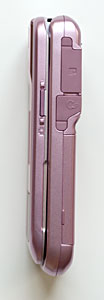|
Advertisement
|
Home -> Phone Reviews -> Sanyo Katana DLX
Sanyo Katana DLX
Editor's rating (1-5):    
Discuss this product
Reviewed August 21, 2007 by Tong Zhang, Senior Editor
Editor's Note 9/2008: Check out our review of the new Katana Eclipse that replaces the DLX.
Last summer, Sprint launched the original Sanyo Katana as their answer to the Motorola RAZR. It sold reasonably well to Sprint customers who craved a slim feature phone back in the days when Sprint didn’t have the RAZR. This summer, Sprint and Sanyo released the Katana II, an update to the original Katana, and the Katana DLX, a Katana on steroids. The DLX betters the original Katana and the Katana II by adding EV-DO Power Vision support, access to the Sprint Music Store and Sprint TV video services, a 1.3 megapixel camera, increased internal memory from 5MB to 21MB and an expansion slot that supports up to 4GB storage cards.
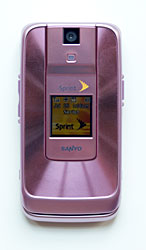
The Katana DLX is a dual band digital CDMA phone with EV-DO (Sprint Power Vision). It’s available in three colors: Platinum Ice, Champagne and Pink Satin.
Design and Ergonomics
The original Katana had a plasticy look that gave it an entry-level image. The Katana DLX still looks a bit plasticy but got a shiny makeover with its mirror-like finish. It’s smaller than the original Katana, measuring in at 3.7 x 1.9 x 0.6 inches (though ever so slightly thicker). It has more curved edges compared to the original and those edges do make the phone look better. The camera lens and flash live on the front plate above the external color display with the camera quick launch button and volume controls on each side of the flip panel. Inside the phone, we found keys that are raised and easy to press. The keypad backlight is in dim blue, which makes it a little difficult to see in certain lighting conditions.
The Katana DLX has a rear-firing speaker that’s loud and there’s a dedicated speaker launch key that sits in between the Talk and End keys. The microSD card slot lives on the right side of the Katana DLX with a standard 2.5mm headset jack right below it, and the charging port lives on the left. The battery is under a latched door on the back of the phone.
Phone Features and Reception
The Katana DLX is a CDMA digital dual-band phone that operates on Sprint’s 800/1900MHz networks with EVDO (Sprint Power Vision) for data. The DLX has great reception, and gets a stronger signal strength than the LG MUZIQ and the Samsung UpStage. The voice quality is quite good. We didn’t experience any dropped calls in the Dallas Metroplex area.
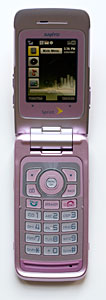
The Katana DLX has a nice set of call management features including call waiting, three-way calling, call forwarding, call screening and roaming guard. The Contacts application can store up to 500 name entries with 700 total phone numbers, 1000 email addresses and 500 web addresses. You can also put street address, assign ringers and caller ID to a contact and assign contacts to groups. The Katana DLX has support for speed dialing, but you can only assign 8 speed dials. While the Katana DLX doesn’t come with speech recognition software for voice dialing, it does offer voice tag-style voice dialing. You must record voice tags for each contact entry you wish to use with the voice dialing. Once the voice tags are recorded, you will be able to make calls using the voice tags, voice dial through Bluetooth headsets and car kits. You can record voice tags for up to 30 contact entries. If you need more that this, you can use Sprint’s Voice Command services for a monthly service fee. For a better hands-free driving experience the Katana DLX does offer a voice guide feature where the phone will read out the keys you press on the phone so that you can hear what you are doing while not looking at the phone.
Display, Gaming and Multimedia
The Katana DLX has a 2” TFT QVGA internal (main) LCD that can display 260K colors. The display is reasonably bright and color saturated and photos look good. In comparison, the LG MUZIQ phone which sells for less has a larger and sharper display. You can set the display brightness on the Katana DLX as well as assign screen savers. The Katana DLX has a 1.0-inch TFT external (sub) LCD that’s capable of displaying 65K colors.
The Katana DLX is a good multimedia feature phone that has access to Sprint Music Store, Sprint TV, On Demand and mobile games. In comparison the Katana II doesn’t have support for Sprint’s Power Vision (EV-DO) or the Sprint Music Store and Sprint TV. When you get Sprint’s Power Vision data pack with the Katana DLX, you can buy tracks for $0.99, which is the lowest among carriers in the US. You can play MP3/AAC/AAC+ music files on the Katana DLX through the built-in speaker or through a headset via the standard 2.5mm stereo headset jack. Audio sounds great through the headphone jack, and the audio through the built-in speaker is decent. The Katana DLX supports Bluetooth A2DP and AVRCP which means you listen to stereo music wirelessly over Bluetooth.
|
|
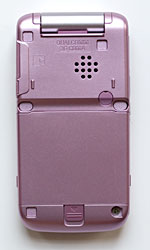
|
|
Video quality via Sprint TV is on par with other Sprint feature phones including the LG MUZIQ. If you haven’t used Sprint TV, it’s a service that provides on-demand and live mobile video clips in 50 channels. These clips include news, weather, sports, entertainment and even full-length shows like Lost, Desperate Housewives, etc. A lot of these channels are free, and there are even more if you want to pay for the extra channels. The video quality varies widely from channel to channel, and program to program. Some videos are good like TV shows and some of the sports clips; others have terrible frame rates, very low resolution and are often hard to watch such as some E! programs, some of the news channels and more. In general, the digital mobile broadcast TV content on Verizon (powered by MediaFlo) wipes the floor quality wise with current on-demand video services including Sprint TV and Verizon V CAST videos.
The Katana DLX has a microSD card slot that supports up to 4GB microSD cards. You can store a lot of music, photos and videos on a 4GB card. The Katana DLX actually comes with a 128MB card to get you started and the phone will format the card automatically and add the appropriate folders for the various content types (the content has to be in the right folders for the phone to it).
Camera
Another upgrade on the Katana DLX is the 1.3 megapixel camera vs. the VGA camera found on the original Katana and the Katana II. It’s a big improvement not only in pixel count but also in picture quality. The photos taken with the Katana DLX look sharp, color balanced and with good contrast in both indoor and outdoor shots. The camera application over-sharpens the photos in a generally pleasing manner. There is no noticeable colorcast in most photos and the Katana DLX deals with contrast better than most 1.3 megapixel camera phones. There’s still some whiteout in direct sunlight, which is common among camera phones, but it’s not too bad by 1.3 megapixel standards. Some intense colors also overwhelm digital cameras and the DLX camera has some issue with that as well. Like most low megapixel digital camera phones, indoor shots have some noise. But the indoor images are quite useable as the noise level isn’t very high and post-production with a desktop image editor can reduce the noise.
The Katana DLX can take photos at three resolutions: 960 x 1280, 480 x 640 and 240 x 320 pixels. You can save the photos to either the phone’s internal memory or a microSD card, post them online, print them to a PictBridge printer or Bluetooth printer, send them to other phones and computers via Bluetooth, or you can send photos to as many as 25 people at a time via MMS. Photos copy fast from the phone to the memory card.
The Katana DLX can also take video with audio at either 176 x 144 or 128 x 96 resolution. You can record videos suitable for MMS or long movies, and record videos with or without sound. Video clips taken with the DLX had decent quality, and the audio was in sync with video.

|
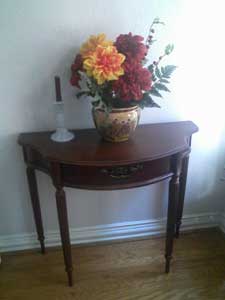 |
Bluetooth
The Katana DLX has integrated Bluetooth v2.0 and supports a large number of Bluetooth profiles. In addition to the Headset and Hands-Free profiles for headsets and car kits, the Katana DLX also supports, DUN (Dial-Up Networking) which allows you to use your phone as a modem for your laptop via Bluetooth, FTP, BPP and most likely to impress music fans, A2DP and AVRCP that will enable users to listen to music and control playback via Bluetooth wireless headsets. Sending contact cards, photos and other files via Bluetooth to desktop machines (we tested PC and Mac) was fast and painless.
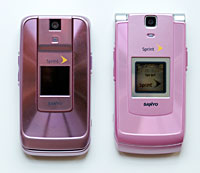
The Katana DLX and Katana II |
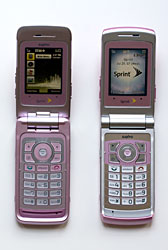
The Katana DLX and Katana II
|
We tested several mono Bluetooth headsets and stereo Bluetooth headsets, and the Katana DLX paired with all easily. When working with the Plantronics Explorer 330, the Katana DLX had very good voice quality on both incoming and outgoing ends. The voice was clear, and volume was very loud. The DSP worked somewhat effectively: it reduced background noise but that noise was still noticeable. Voice dialing over the headset worked flawlessly. Range was not good with the Explorer 330, reaching only about 7 feet before we heard choppy audio and crackling sounds. The SouthWing SH440 Bluetooth didn’t sound as good as the Plantronics. The voice was muffled on both incoming and outgoing ends, like someone was talking with a sock over their mouth. The background noise was clearer and more noticeable than on the Explorer 330, but range was slightly better reaching at about 10 feet. Voice dialing over the SouthWing worked well.
For streaming music wirelessly over Bluetooth stereo headsets, we tested the Plantronics Pulsar 590A and the Motorola S9 Bluetooth stereo headsets. The music quality was very good on both with exception of white noise hissing on the S9. The S9 has this hiss with most A2DP phones we’ve tested except on the Nokia 6120 Classic and the Nokia N76; so we can’t fault the Katana DLX entirely, but the noise was very noticeable on the DLX. The Katana DLX had really nice audio quality via the Pulsar 590 and it’s a joy to listen to rock, blues and even classical music on the headphones. Voice dialing via the headphones worked well and the AV controls also performed fine. Volume was loud on both headsets. Voice quality for phone calls was decent and range was about 20 feet with both headsets.
Battery Life
The Katana DLX comes with a standard rechargeable 3.7v Lithium-Ion battery (model: SCP-28LBPS) that’s user replaceable. The claimed talk time is 4 hours, which is on par with our test results. If you need longer runtimes, you can buy the extended battery which increases talk time to 6 hours. There isn’t an official number for the standby time, but our unit lasted for at least a week in standby. You can save power by dimming the display and keypad backlight among other things. But the biggest battery drain is still accessing Sprint’s Power Vision sites for music downloads, watching Sprint TV videos and web browsing. Downloading music and watching Sprint TV will eat up a full charge in 1.75 to 2 hours.
Software
The Katana DLX comes with text messaging, picture mail, web-based email (AOL, Yahoo, Gmail, etc.) and voice SMS clients for your messaging needs. There is also a web-based IM that including AOL, MSN and Yahoo instant messenger support.
Like the LG MUZIQ, the Katana DLX comes with excellent On-Demand software which is powered by Handmark. You get local information including weather with a current radar view of your local area and movie times from your local theaters. There are also national news, stocks, sports content and more.
Personal information tools include Contacts, Calendar/To-Do list, alarm clock, world clock, stop watch, countdown timer and calculator.
Conclusion
A clear step up from the original Katana, the DLX not only has a better look but it scores EV-DO, a better camera and extra multimedia bonuses that make it more comparable to the LG MUZIQ from Sprint and the LG VX8600 on Verizon. Folks who just want a basic starter phone can go with the updated Katana II, but those who want a step up in features and data should give the Katana DLX a look.
Pro: Better aesthetics than the original Katana with pleasing curves and color choices. Strong signal strength and fast data speed by EV-DO standards on feature phones. Support for $.99 per song music store with a Power Vision plan. Comes with Sprint TV and On-Demand. A2DP and AVRCP support. Good camera quality by 1.3MP camera phone standards. Good battery life.
Con: Keyboard backlight is dim. Limited numbers of speed dial entries (up to 8) and voice tags (up to 30). No external music controls.
Price: $129.99 with a two-year subscriber agreement and a $50 mail-in rebate.
Web sites: www.sanyo.com www.sprint.com
|
Display:: 2.0-inch TFT QVGA LCD Main display, 260K colors. 1.0-inch TFT LCD Sub display, 65K colors.
Battery: Sanyo standard Lithium-Ion battery, 920 mAh, 3.7v. Model number: SCP-28LBPS.
Performance: Undisclosed processor. 21MB internal memory. Contacts can hold up to 500 contacts.
Size: 3.7 x 1.9 x 0.6 inches. Weight: 3.5 ounces.
Phone: CDMA digital dual band (800/1900 MHz) with EVDO for data.
Camera: 1.3MP with up to 12x digital zoom.
Audio: Built-in mono speaker, mic and standard 2.5mm headphone jack. Voice tag dialing supported, 72-Chord Polyphonic ringers. Voice memo up to 3 minutes. Vibrating alert supported.
Networking: Bluetooth v2.0. Supported profiles include: GAP, SPP, GOEP (General), HSP (Headsets), HFP 1.5 (Hands-free), OPP (vCard transfer), DUN (Dial-up networking), FTP (File Transfer), BPP (Bluetooth Printing), BPP (Bluetooth Printing), A2DP, AVRCP (Stereo Bluetooth) and PBAP (Phone Book Access).
Software: Icon/text-based menu interface. Contacts, Calendar/To-Do list, alarm clock, world clock, stopwatch, countdown timer and calculator. Music player, Sprint TV and On Demand included. SMS, MMS, VoiceSMS, web browser, Mass storage (to PC), PictBridge onboard. Voice tag for voice dialing.
Expansion: 1
microSD slot, 128 meg card included. Supports up to 4 gig cards.
In the Box: The Katana DLX with standard Lithium Ion battery, AC charger, 128MB microSD card with SD card adapter, printed User Guide and other Sprint documentation.
|
|
|




